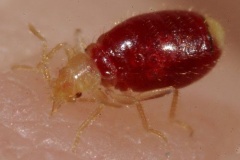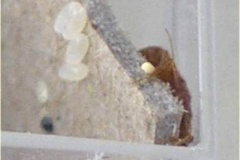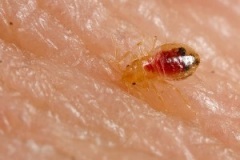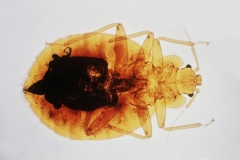Bed bugs are natural parasites of people, evolving with human populations for the past 35,000 years. Insecticides developed in the 20th century nearly eradicated bed bugs from developed nations, but since the early 2000s, population growth and increased international travel, as well as mounting pesticide resistance, have brought bed bugs back with a vengeance.
There are not a lot of cost-effective options for dealing with them. And because they are so highly resistant to the pesticides we use for their control, they are spreading faster than ever, said Dini Miller, urban pest management specialist for Virginia Cooperative Extension and associate professor of entomology in the College of Agriculture and Life Sciences.
Associate Professor Dini Miller, at left, and master's student Molly Stedfast are studying bed bugs and teaching people how to manage infestations in homes and businesses.
Miller and her colleagues at the Virginia Tech Dodson Urban Pest Management Laboratory began investigating bed bugs in 2004 by studying pesticide resistance and new approaches to their control. A large part of their work involves teaching people how to manage bed bug infestations in homes and businesses. In addition, Miller works with home health care workers, social services, apartment and shelter managers, and school facilities personnel to raise awareness.
Millers team is focusing on the growing bed bug problem in multi-unit housing complexes, particularly those whose tenants have limited resources. "Elderly and disabled residents are particularly vulnerable to bed bugs. They may not be able to see them or to defend themselves against receiving hundreds of bites a night, Miller said.
Bed bugs are a nightmare for housing managers.
When bed bugs get into the walls, they can spread from unit to unit, so instead of one unit being infested, multiple units may be infested within a period of months, Miller said. Some apartment complexes have seen their pest management costs increase by $30,000 or even $100,000 in one year. We are working with apartment complexes to get them to invest in a prevention program to keep bed bugs from spreading.
Molly Stedfast of Norfolk, Va., a masters student in entomology who works with Miller, said, Our research is based on the idea that if we can teach people easy, inexpensive, nonchemical methods they can use to better protect themselves from bed bugs, we can reduce the problem overall.
All life stages of the bed bug are visible to the naked eye. Adults are flat and about 4 to 5 millimeters long, about the same shape and color as an apple seed. Immature bed bug nymphs are translucent and yellowish in color and about 1.5 millimeters long, about the size of a comma in a paperback book.
Stedfast has traveled to several locations affected by bed bugs, including Harrisonburg and Richmond, Va., and New Orleans. At each apartment complex, she uses simple methods to train staff members and residents to recognize and safely prevent bed bug infestations.
Read this article:
Entomologists promote prevention as a defense against bed bugs ...

 Residence
Residence  Location
Location 










